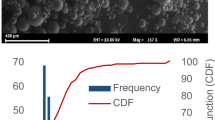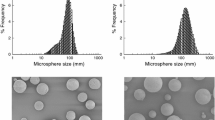Abstract
A new spinning oil film (SOF) solid-in-oil-in-oil emulsion process was developed to produce uniform-sized proteinloaded biodegradable microspheres. A thin SOF on a cylindrical rotor was used to shear droplets from a nozzle tip to control droplet size. The resulting microspheres with low polydispersity (6%) produced a low burst (6%–11%) release even at high loadings (13%–18% encapsulated solids, 8%–12% protein). The SOF process had a high yield and did not require the presence of water, which can cause protein denaturation, or surfactants, which may be unwanted in the final product. Amorphous protein and crystalline excipient solids were encapsulated into 3 different polymers, giving a homogenous drug distribution throughout the microspheres, and an essentially complete protein encapsulation efficiency (average=99%). In contrast, large burst release was observed for polydisperse microspheres produced by a conventional emulsification technique, particularly for microspheres smaller than 25 μm in diameter, which gave 93% burst at 15% loading. The uniform encapsulation of high loadings of proteins into microspheres with low polydispersity in an anhydrous process is of practical interest in the development of controlled-release protein therapeutics.
Similar content being viewed by others
References
Sinha VR, Trehan A. Biodegradable microspheres for protein delivery.J Control Release. 2003;90:261–280.
TAP Pharmaceutical Products Inc. LupronDepot. Available at: http://www.tap.com/prd_ldep.asp. Accessed: September 23, 2004.
Cleland JL, Johnson OL, Putney S, Jones AJS. Recombinant human growth hormone poly(lactic-co-glycolic acid) microsphere formulation development.Adv Drug Deliv Rev. 1997;28:71–84.
Genentech Inc. Genentech’s Growth Hormone Web site. Available at: http://www.nutropin.com/index.jsp. Accessed: September 23, 2004.
Johnson OL, Tracy MA. Peptide and protein drug delivery. In: Mathiowitz E, ed.Encyclopedia of Controlled Drug Delivery. Vol 2. Hoboken, NJ: John Wiley and Sons; 1999:816–832.
Jain RA. The manufacturing techniques of various drug loaded biodegradable poly(lactide-co-glycolide) (PLGA) devices.Biomaterials. 2000;21:2475–2490.
Perez C, Castellanos IJ, Costantino HR, Al-Azzam W, Griebenow K. Recent trends in stabilizing protein structure upon encapsulation and release from bioerodible polymers.J Pharm Pharmacol. 2002;54:301–313.
Castellanos IJ, Carrasquillo KG, Lopez JD, Alvarez M, Griebenow K. Encapsulation of bovine serum albumin in poly(lactide-co-glycolide) microspheres by the solid-in-oil-in-water technique.J Pharm Pharmacol. 2001;53:167–178.
Griebenow K, Klibanov AM. On protein denaturation in aqueousorganic mixtures but not in pure organic solvents.J Am Chem Soc. 1996;118:11695–11700.
Leach WT, Simpson DT, Val TN, et al. Uniform encapsulation of stable protein nanoparticles produced by spray freezing for the reduction of burst release.J Pharm Sci. 2005;94:56–69.
Berkland C, Kim K, Pack DW. PLG microsphere size controls drug release rate through several competing factors.Pharm Res. 2003;20:1055–1062.
Jalil R, Nixon JR. Microencapsulation using poly(L-lactide). II. Preparative variables affecting microcapsule properties.J Microencapsul. 1990;7:25–39.
Berkland C, Kim K, Pack DW. Fabrication of PLG microspheres with precisely controlled and monodisperse size distributions.J Control Release. 2001;73:59–74.
Berkland C, King M, Cox A, Kim K, Pack DW. Precise control of PLG microsphere size provides enhanced control of drug release rate.J Control Release 2002;82:137–147.
Umbanhowar PB, Prasad V, Weitz DA. Monodisperse emulsion generation via drop break off in a coflowing stream.Langmuir. 2000;16:347–351.
Li YX, Kissel T. Synthesis and properties of biodegradable ABA triblock copolymers consisting of poly(L-lactic acid) or poly(L-lactic-co-glycolic acid) A-blocks attached to central poly(oxyethylene) B-blocks.J Control Release. 1993;54:99–134.
Yu Z III, Garcia AS III, Johnston KP III, Williams RO III. Spray freezing into liquid for highly stable protein nanostructured microparticles.Eur J Pharm Biopharm. 2004;58:529–537.
Yu Z III, Rogers TL III, Hu J III, Johnston KP III, Williams RO III. Preparation and characterization of microparticles containing peptide produced by a novel process: spray freezing into liquid.Eur J Pharm Biopharm. 2002;54:221–228.
Sanchez A, Villamayor B, Guo YY, McIver J, Alonso MJ. Formulation strategies for the stabilization of tetanus toxoid in poly (lactide-co-glycolide) microspheres.Int J Pharm. 1999;185:255–266.
Iwata M, Nakamura Y, McGinity JW. Particle size and loading efficiency of poly(D,L-lactic-co- glycolic acid) multiphase micropheres containing water soluble substances prepared by the hydrous and anhydrous solvent evaporation methods.J Microencapsul. 1999;16:49–58.
Jiang W, Schwendeman SP. Stabilization of a model formalinized protein antigen encapsulated in poly(lactide-co-glycolide)-based microspheres.J Pharm Sci. 2001;90:1558–1569.
Jiang W, Schwendeman SP. Stabilization and controlled release of bovine serum albumin encapsulated in poly(D, L-lactide) and poly (ethylene glycol) microsphere blends.Pharm Res. 2001;18:878–885.
Cleland JL. Solvent evaporation processes for the production of controlled release biodegradable microsphere formulations for therapeutics and vaccines.Biotechnol Prog. 1998;14:102–107.
Cleland JL, Lim A, Barron L, Duenas ET, Powell MF. Development of a single-shot subunit vaccine for HIV-1.4: optimizing microencapsulation and pulsatile release of MN rgp120 from biodegradable microspheres.J Control Release. 1997;47:135–150.
Lam XM, Duenas ET, Daugherty AL, Levin N, Cleland JL. Sustained release of recombinant human insulin-like growth factor-I for treatment of diabetes.J Control Release. 2000;67:281–292.
Wang J, Wang BA, Schwendeman SP. Characterization of the initial burst release of a model peptide from poly(D,L-lactide-co-glycolide) microspheres.J Control Release. 2002;82:289–307.
Kissel T, Li YX, Unger F. ABA-triblock copolymers from biodegradable polyester A-blocks and hydrophilic poly(ethylene oxide) B-blocks as a candidate for in situ forming hydrogel delivery systems for proteins.Adv Drug Deliv Rev. 2002;54:99–134.
Author information
Authors and Affiliations
Corresponding author
Additional information
Published: December 6, 2005
Rights and permissions
About this article
Cite this article
Leach, W.T., Simpson, D.T., Val, T.N. et al. Encapsulation of protein nanoparticles into uniform-sized microspheres formed in a spinning oil film. AAPS PharmSciTech 6, 75 (2005). https://doi.org/10.1208/pt060475
Received:
Accepted:
DOI: https://doi.org/10.1208/pt060475




